More than just riding between the lines
September 12, 2013
The information published here was taken from Motorcycle.com.
For the complete article and its comments click on the link below:
http://www.motorcycle.com/how-to/proper-motorcycle-lane-positioning
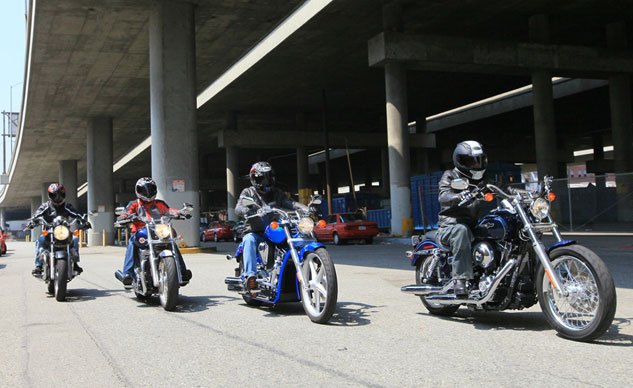
Being smaller than the majority of road users is both an advantage and disadvantage of riding a motorcycle. However, many riders don’t give much active consideration to how they can apply a motorcycle’s advantages to help mitigate its disadvantages. Thanks to lane positioning options afforded by a bike’s small size, we can take proactive steps to keep those big, lumbering cars from becoming overly intimate with us.
The width of cars pretty much limits them to one place within a lane. If their driver can just keep it between the lines, they’re golden. Motorcycles, thanks to their being narrow, single-track vehicles, have a seemingly infinite number of slices within a lane that they can occupy. However, for the sake of simplicity, we’ll divide the lane into thirds: left, right and center. Think of these as lanes within the lane. Your choice of position within the lane can do two important things.
First, by creating a protective bubble of space around you (a “space cushion” in MSF parlance), you can give yourself more time to react should an inattentive car driver start claiming more than his fair share of the road. If you are traveling in the left lane overtaking a car on your right, you will be less vulnerable if you ride in the left third of the lane when passing through the car’s blind spot. Similarly, if a car is overtaking you, move to the third of the lane opposite that vehicle.
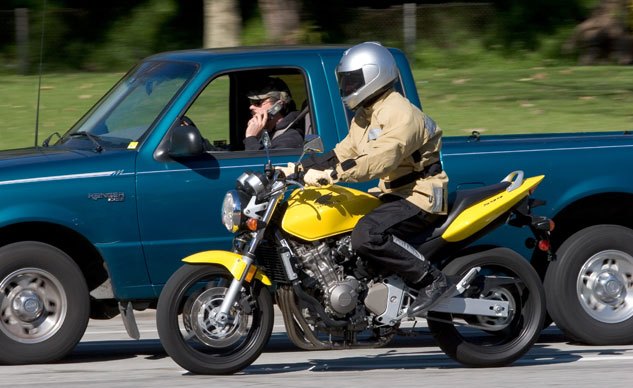
Riding this close to an inattentive driver gives you no time to react. Make sure you have a space cushion.
The second benefit of lane positioning is that you can make yourself more visible to other traffic. If you’re following a car, stay in the center third so that your headlight can’t be missed in a car’s rear view mirror. Do the same when traveling in front of a car, too – but remember that a tail light doesn’t capture a driver’s attention as well as your high beam. When overtaking a car on its left, you can combine space cushioning with lane placement for better visibility.
As you approach the car, make sure you are in the right third of your lane, keeping your headlight in the car’s side mirror. Just before you enter the car’s blind spot, move to the left third of the lane and immediately move back to the right third once you are safely past the car. This keeps you as far as possible from the car when the driver can’t see you, but inserts your motorcycle back into their field of vision as you move in front of them. Your movement from the left to the right third of the lane should also attract the driver’s attention, pointing out that there’s someone new in front of them. As you navigate through traffic, you will constantly need to adjust your lane position to maximize your space cushion and visibility.
Unfortunately, traffic situations don’t always occur in ways that allow you to deal with them individually, as you could in the previous examples. Sometimes, if you pause for a moment, they will naturally separate in the flow of traffic, but in most cases, you’ll have to take what you’re given. In these instances, address the issues simultaneously.
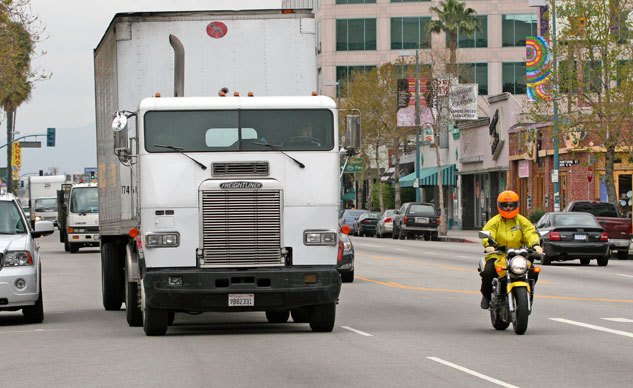
Maintain your cushion until you are past the vehicle and can place your bike into the driver’s line of sight.
If cars are both on the left and the right of your intended path of travel, choosing either side of the lane would compromise your space cushion with one of the vehicles. So, you’ll need to split the difference to get the most separation possible from both by passing them in the middle third of the lane. While this is not an ideal situation with either car, it does give you the best option for this scenario.
Make a game out of plotting the route you’d take while observing traffic – even if you’re not riding at the time. After all, isn’t having to constantly interact with your surroundings in an intellectually active way one of the attractions of riding? If you just wanted to sit on your ass traveling from point A to B, you’d be in a car…talking on a cell phone.
Finally, many riders neglect to consider the message they are sending to drivers with their lane position. The sad truth is that, as fewer people use their turn signals, drivers are being forced to make assumptions based on limited information about what the other road users are going to do.
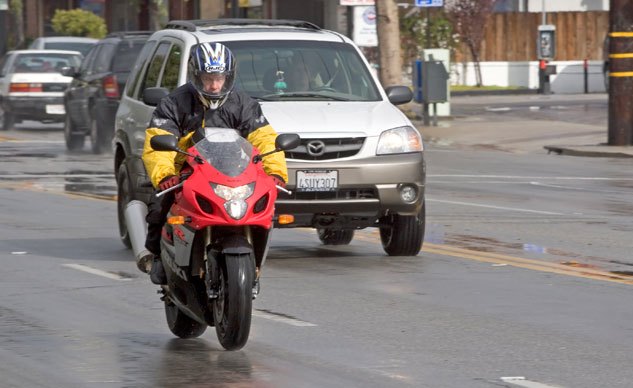
This rider has placed himself in a position to be more visible to the driver. If the car is overtaking the motorcycle, moving to the right would increase the space cushion as the car passed.
So, consider the signals you send to other road users through your actions within your lane. For example, how you would appear to an oncoming car when you ride in the left third of the left lane as you both approach an intersection? Your lane position could be misinterpreted as preparing to turn left, which could prompt the other driver to initiate his turn right in front of you. Instead, shift to the right third of your lane as you approach the intersection.
Could your shift to the right third of the lane be sending a different message when it occurs on a two-lane road rather than a four-lane one? Moving to the center of your lane on a two lane road would not give you as much of a space cushion, but there is less of a chance that your move will be interpreted as preparing to turn right than if you’d moved all the way over to the right third.
Either way, by moving away from the other car, you’ve increased your space cushion and clearly stated that you have no intention of turning left. Another benefit is that by switching positions, you’ve caused your headlight to waver, drawing the distracted driver’s attention to you.
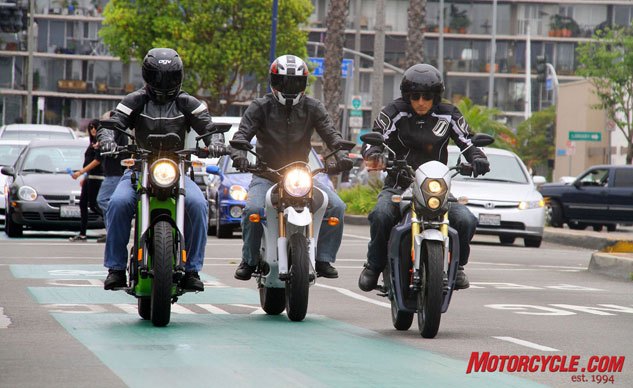
As with any other riding skill, the more you use it, the more natural it becomes, so practice on every ride. Gradually, your choices of lane positioning will become intuitive, leaving you to use more of your concentration analyzing the traffic ahead of you – or just having fun with the wind in your face.
